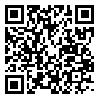Wed, Dec 31, 2025
Volume 30, Issue 1 (1-2020)
JHNM 2020, 30(1): 27-34 |
Back to browse issues page
Download citation:
BibTeX | RIS | EndNote | Medlars | ProCite | Reference Manager | RefWorks
Send citation to:



BibTeX | RIS | EndNote | Medlars | ProCite | Reference Manager | RefWorks
Send citation to:
Faghani Aghoozi M, Kariman N, Faiazi S, Joze Mohtashami M, Amerian M. Factors Affecting the First Childbearing Decision in
Iranian Males. JHNM 2020; 30 (1) :27-34
URL: http://hnmj.gums.ac.ir/article-1-1015-en.html
URL: http://hnmj.gums.ac.ir/article-1-1015-en.html
Marzieh Faghani Aghoozi1 

 , Nourossadat Kariman2
, Nourossadat Kariman2 

 , Sanaz Faiazi3
, Sanaz Faiazi3 

 , Mona Joze Mohtashami4
, Mona Joze Mohtashami4 
 , Maliheh Amerian *5
, Maliheh Amerian *5 




 , Nourossadat Kariman2
, Nourossadat Kariman2 

 , Sanaz Faiazi3
, Sanaz Faiazi3 

 , Mona Joze Mohtashami4
, Mona Joze Mohtashami4 
 , Maliheh Amerian *5
, Maliheh Amerian *5 


1- Instructor, Department of Midwifery, School of Nursing and Midwifery, Shahroud University of Medical Sciences, Shahroud, Iran
2- Associate Professor, Department of Midwifery and Reproductive Health, School of Nursing and Midwifery, Shahid Beheshti University of Medical Sciences, Tehran, Iran
3- Instructor, Department of Midwifery, School of Nursing and Midwifery, Zanjan University of Medical Sciences, Zanjan, Iran
4- Instructor, Department of Anesthesiology, School of Allied Medicine, Shahroud University of Medical Sciences, Shahroud, Iran
5- Instructor, Department of Midwifery, School of Nursing and Midwifery, Shahroud University of Medical Sciences, Shahroud, Iran ,m.amerian43@yahoo.com
2- Associate Professor, Department of Midwifery and Reproductive Health, School of Nursing and Midwifery, Shahid Beheshti University of Medical Sciences, Tehran, Iran
3- Instructor, Department of Midwifery, School of Nursing and Midwifery, Zanjan University of Medical Sciences, Zanjan, Iran
4- Instructor, Department of Anesthesiology, School of Allied Medicine, Shahroud University of Medical Sciences, Shahroud, Iran
5- Instructor, Department of Midwifery, School of Nursing and Midwifery, Shahroud University of Medical Sciences, Shahroud, Iran ,
Abstract: (2901 Views)
Abstract
Introduction: Childbearing results from a productive behavior within the family arisen from couples’ decision to have children. The role of men in making decisions about childbearing and their intentions are often overlooked in studies. Objective: This study aimed to investigate males’ first childbearing decision and their contributing factors.
Materials and Methods: This was an analytical and cross-sectional study. In total, 300 married men aged 18-45 years participated in this study. The subjects accompanied their wives with the first pregnancy to receive prenatal care at hospitals and private health centers of Shahroud County, Iran. They were selected randomly. The required data were collected using A demographic form, Snyder’s Adult Hope Scale (AHS), and World Health Organization Quality of Life (WHOQOL-BREF) questionnaire. The correlation between study variables was examined by Pearson’s correlation coefficient and Multiple Linear Regression analysis.
Results: The mean age at first childbearing decision and age at marriage in men were 28.8±3.74 and 25.59±3.68 years, respectively. Among the factors related to first childbearing decision, age at marriage suggested the highest association (r=0.89, P=0.001). The age at first childbearing decision also had a statistically significant relationship with marriage duration (r=0.29, P=0.001), and education (r=0.16, P=0.001). Quality of life had a negative significant correlation with it (r=-0.22, P=0.001). Age at marriage revealed the highest power for predicting contributing factors. With the 10-year increase in men's marriage age, the age at first childbearing decision increased by 8.9 years; with the 1-point increase in quality of life score, the age decreased by 0.09 years, if other variables remained constant.
Conclusion: Age at marriage and quality of life could affect age at first childbearing decisions in men. The healthcare team and policymakers should facilitate childbearing conditions. This could be achieved by providing accurate knowledge about these factors. As a result, men can achieve the desired number of children at the right time.
Introduction: Childbearing results from a productive behavior within the family arisen from couples’ decision to have children. The role of men in making decisions about childbearing and their intentions are often overlooked in studies. Objective: This study aimed to investigate males’ first childbearing decision and their contributing factors.
Materials and Methods: This was an analytical and cross-sectional study. In total, 300 married men aged 18-45 years participated in this study. The subjects accompanied their wives with the first pregnancy to receive prenatal care at hospitals and private health centers of Shahroud County, Iran. They were selected randomly. The required data were collected using A demographic form, Snyder’s Adult Hope Scale (AHS), and World Health Organization Quality of Life (WHOQOL-BREF) questionnaire. The correlation between study variables was examined by Pearson’s correlation coefficient and Multiple Linear Regression analysis.
Results: The mean age at first childbearing decision and age at marriage in men were 28.8±3.74 and 25.59±3.68 years, respectively. Among the factors related to first childbearing decision, age at marriage suggested the highest association (r=0.89, P=0.001). The age at first childbearing decision also had a statistically significant relationship with marriage duration (r=0.29, P=0.001), and education (r=0.16, P=0.001). Quality of life had a negative significant correlation with it (r=-0.22, P=0.001). Age at marriage revealed the highest power for predicting contributing factors. With the 10-year increase in men's marriage age, the age at first childbearing decision increased by 8.9 years; with the 1-point increase in quality of life score, the age decreased by 0.09 years, if other variables remained constant.
Conclusion: Age at marriage and quality of life could affect age at first childbearing decisions in men. The healthcare team and policymakers should facilitate childbearing conditions. This could be achieved by providing accurate knowledge about these factors. As a result, men can achieve the desired number of children at the right time.
Article Type : Research |
Subject:
Special
Received: 2019/10/20 | Accepted: 2019/11/27 | Published: 2020/01/1
Received: 2019/10/20 | Accepted: 2019/11/27 | Published: 2020/01/1
Send email to the article author
| Rights and permissions | |
 | This work is licensed under a Creative Commons Attribution-NonCommercial 4.0 International License. |



